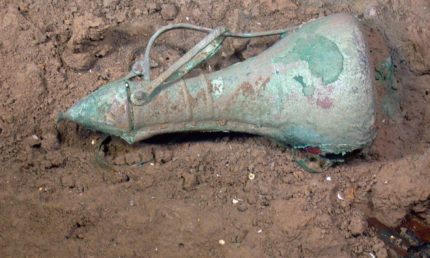Maritime archaeologists have discovered a dozen shipwrecks off the coast of Lebanon in the Levantine Basin. Ranging in date from the 3rd century B.C. to the 19th century, there are wrecks from the Hellenistic, Roman, early Islamic and Ottoman eras. A team from the Enigma Shipwrecks Project (ESP) found the wrecks up to a mile deep on the sea floor. They scanned and documented the area with remote operated vehicles, capturing high-resolution images and HD video. The field exploration of the wrecks ended in late 2015, but as researchers continue to work on the data and artifacts, the find has been kept under wraps until now.
 One ship dominated the others in size and in richness of cargo. It was an Ottoman merchant vessel that sank around 1630 during a voyage between Egypt and Istanbul. At 140 feet long displacing 1,000 tons, it was so huge that two regular ships could have fit comfortably on its deck and its hold contained hundreds of artifacts of astonishing diversity representing 14 different cultures, among them western North Africa, China, India, Italy, Spain and Belgium. Artifacts include the earliest Chinese porcelain ever found on a Mediterranean wreck, Italian ceramics and Indian peppercorns.
One ship dominated the others in size and in richness of cargo. It was an Ottoman merchant vessel that sank around 1630 during a voyage between Egypt and Istanbul. At 140 feet long displacing 1,000 tons, it was so huge that two regular ships could have fit comfortably on its deck and its hold contained hundreds of artifacts of astonishing diversity representing 14 different cultures, among them western North Africa, China, India, Italy, Spain and Belgium. Artifacts include the earliest Chinese porcelain ever found on a Mediterranean wreck, Italian ceramics and Indian peppercorns.
The objects illustrate the global reach of trade in the early 17th century and how consumer demand in one country drove production of goods across the globe.
The Chinese porcelain includes 360 decorated cups, dishes and a bottle made in the kilns of Jingdezhen during the reign of Chongzhen, the last Ming emperor that were designed for sipping tea, but the Ottomans adapted them for the craze then spreading across the East – coffee drinking. Hidden deep in the hold were the earliest Ottoman clay tobacco pipes found on land or sea. They were probably illicit because there were severe prohibitions then against tobacco smoking.
[ESP archaeologist Sean] Kingsley said: “Through tobacco smoking and coffee drinking in Ottoman cafes, the idea of recreation and polite society – hallmarks of modern culture – came to life. Europe may think it invented notions of civility, but the wrecked coffee cups and pots prove the ‘barbarian Orient’ was a trailblazer rather than a backwater. The first London coffeehouse only opened its doors in 1652, a century after the Levant.”
